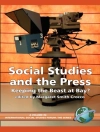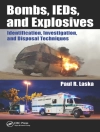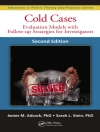’…It is a great textbook for undergrads who are being exposed to statistics in the field for the first time and for Master’s students who need a better grasp of the fundamentals of statistics before taking more advanced courses…’
—Calli M. Cain, University of Nebraska at Omaha
'A must-have textbook for Instructors and students alike in the fields of Criminology and Criminal Justice. The book is user-friendly.’
—Bonny Mhlanga, Western Illinois University
An Introduction to Statistics in Criminology and Criminal Justice
Statistics for Criminology and Criminal Justice, Third Edition demonstrates how statistics is relevant to a student’s life and future career by illustrating the logical connections between basic statistical concepts and their real-world implications in criminology and criminal justice. Written for students with a limited mathematical background, author Jacinta Gau eases student anxiety around statistics by simplifying the overarching goal of each statistical technique and providing step-by-step instructions for working through the formulas and numbers. Students use real data from the field to build a foundational knowledge of statistics, rather than merely memorizing key terms or formulas.
New to the Third Edition
- NEW Thinking Critically feature encourages students to apply the concepts from the chapter to real-life scenarios, with open-ended questions that are designed to inspire students to think about the nuances of science, statistics, and their application to criminal justice.
- Additional illustrations and examples in every chapter keep students engaged with the content and offer ample opportunities for them to practice the techniques.
- New and updated data sets from a wide range of relevant sources, such as the NCVS and UCR, BJS, LEMAS, the Census of Jails, and much more have been incorporated to give students insights into the state of criminal justice research today.
- New research on critical topics encourages students to discuss changes happening in the field such as the Census of Jails, inmate-on-staff assaults in prisons, and homicide rates.
- Practicing Statistics Whiteboard Videos, available in SAGE edge, walk students through statistical calculations to reinforce key concepts.
- Previous edition errors have been corrected by a statistician.
Give your students the SAGE edge!
SAGE edge offers a robust online environment featuring an impressive array of free tools and resources for review, study, and further exploration, keeping both instructors and students on the cutting edge of teaching and learning.
Spis treści
Preface to the Third Edition
Acknowledgments
About the Author
PART I DESCRIPTIVE STATISTICS
Chapter 1 Introduction to the Use of Statistics in Criminal Justice and Criminology
Science: Basic Terms and Concepts
Types of Scientific Research in Criminal Justice and Criminology
Software Packages for Statistical Analysis
Organization of the Book
Review Problems
Chapter 2 Types of Variables and Levels of Measurement
Units of Analysis
Independent Variables and Dependent Variables
Relationships Between Variables: A Cautionary Note
Levels of Measurement
Chapter Summary
Review Problems
Chapter 3 Organizing, Displaying, and Presenting Data
Data Distributions
Graphs and Charts
Grouped Data
SPSS
Chapter Summary
Review Problems
Chapter 4 Measures of Central Tendency
The Mode
The Median
The Mean
Using the Mean and Median to Determine Distribution Shape
Deviation Scores and the Mean as the Midpoint of the Magnitudes
SPSS
Chapter Summary
Review Problems
Chapter 5 Measures of Dispersion
The Variation Ratio
The Range
The Variance
The Standard Deviation
The Standard Deviation and the Normal Curve
SPSS
Chapter Summary
Review Problems
PART II PROBABILITY AND DISTRIBUTIONS
Chapter 6 Probability
Discrete Probability: The Binomial Probability Distribution
Continuous Probability: The Standard Normal Curve
Chapter Summary
Review Problems
Chapter 7 Population, Sample, and Sampling Distributions
Empirical Distributions: Population and Sample Distributions
Theoretical Distributions: Sampling Distributions
Sample Size and the Sampling Distribution: The z and t Distributions
Chapter Summary
Review Problems
Chapter 8 Point Estimates and Confidence Intervals
The Level of Confidence: The Probability of Being Correct
Confidence Intervals for Means With Large Samples
Confidence Intervals for Means With Small Samples
Confidence Intervals With Proportions and Percentages
Chapter Summary
Review Problems
PART III HYPOTHESIS TESTING
Chapter 9 Hypothesis Testing: A Conceptual Introduction
Sample Statistics and Population Parameters: Sampling Error or True Difference?
Null and Alternative Hypotheses
Chapter Summary
Review Problems
Chapter 10 Hypothesis Testing With Two Categorical Variables: Chi-Square
Conceptual Basis of the Chi-Square Test: Statistical Dependence and Independence
The Chi-Square Test of Independence
Measures of Association
SPSS
Chapter Summary
Review Problems
Chapter 11 Hypothesis Testing With Two Population Means or Proportions
Two-Population Tests for Differences Between Means: t Tests
Two-Population Tests for Differences Between Proportions
SPSS
Chapter Summary
Review Problems
Chapter 12 Hypothesis Testing With Three or More Population Means: Analysis of Variance
ANOVA: Different Types of Variances
When the Null Is Rejected: A Measure of Association and Post Hoc Tests
SPSS
Chapter Summary
Review Problems
Chapter 13 Hypothesis Testing With Two Continuous Variables: Correlation
Beyond Statistical Significance: Sign, Magnitude, and Coefficient of Determination
SPSS
Chapter Summary
Review Problems
Chapter 14 Introduction to Regression Analysis
One Independent Variable and One Dependent Variable: Bivariate Regression
Adding More Independent Variables: Multiple Regression
Ordinary Least Squares Regression in SPSS
Alternatives to Ordinary Least Squares Regression
Chapter Summary
Review Problems
Appendix A Review of Basic Mathematical Techniques
Appendix B Standard Normal (z) Distribution
Appendix C t Distribution
Appendix D Chi-Square (c²) Distribution
Appendix E F Distribution
Glossary
Answers to Learning Checks
Answers to Review Problems
References
Index
O autorze
Jacinta M. Gau, Ph.D., is an associate professor in the Department of Criminal Justice at the University of Central Florida. She received her doctorate from Washington State University in 2008. Her primary areas of research are policing and criminal justice policy, and she has a strong quantitative background. Dr. Gau’s work has appeared in journals such as Justice Quarterly, British Journal of Criminology, Criminal Justice and Behavior, Crime & Delinquency, Criminology & Public Policy, Police Quarterly, Policing: An International Journal of Police Strategies & Management, and the Journal of Criminal Justice Education. In addition to Statistics for Criminology and Criminal Justice, she is author of Criminal Justice Policy: Origins and Effectiveness (Oxford University Press) and co-author of Key Ideas in Criminology and Criminal Justice (SAGE Publications). Additionally, she co-edits Race and Justice: An International Journal, published by SAGE.












